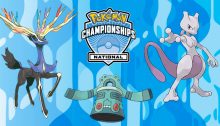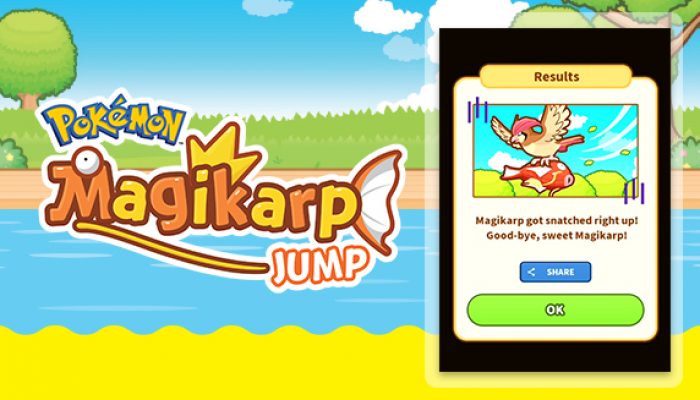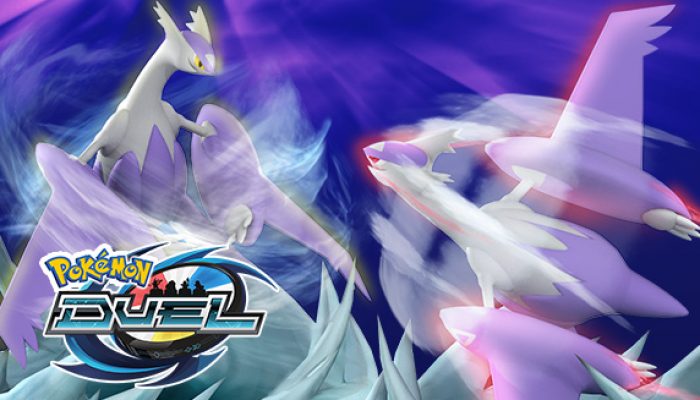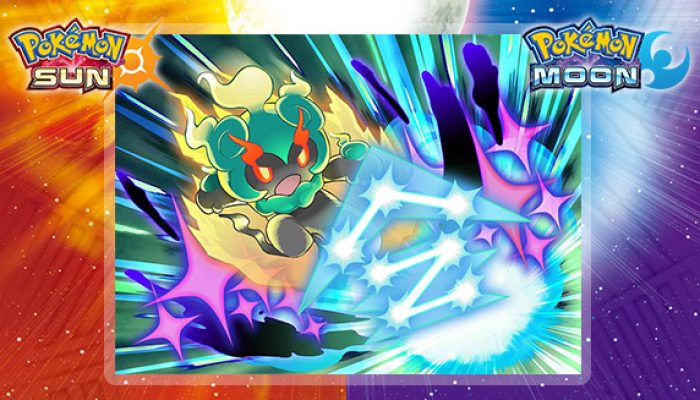 In retrospect, it’s no wonder they went Primal with the format since they knew all along these were the final ORAS championships.
In retrospect, it’s no wonder they went Primal with the format since they knew all along these were the final ORAS championships.
☆ NintendObs Weekly – Monday, July 11, 2016 – Sunday, July 17, 2016.
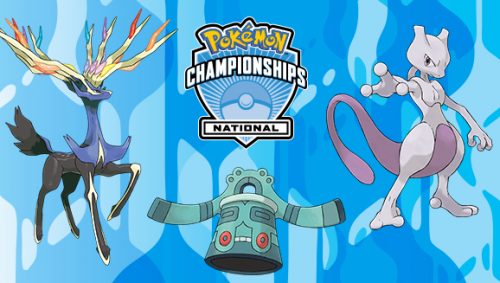
Surprise Stories at the US Video Game National Championships
The 2016 US Pokémon Video Game National Championships revealed an unexpected depth to the current Championship Series metagame, with more interesting teams and Pokémon than many players and spectators planned for. And despite a narrower selection of winning combinations than their TCG counterparts, the video game competitors put on a rousing display of inventive gameplay. After fifteen rounds of best-of-three play and a 12-player Top Cut in the Masters Division, Chase Lybbert has been crowned the National Champion at the 2016 US Pokémon Video Game Masters Division National Championships. Carson St. Denis and Enzo Reci took home impressive victories in the Senior and Junior Divisions, and Trainers have earned their Travel Awards and invitations to the 2016 World Championships in San Francisco.
With so many rounds of intense Pokémon battles in the books, the puzzle of the 2016 Video Game National Championships is now clearer. We’ll break down the teams used at the top tables of the 2016 National Championships and take a look at a Pokémon that proved to be a surprise star in Columbus. Remember that you can check out the teams from the Top Cut in each of the Masters, Senior, and Junior Divisions.
Metagame Musings
Leading into Nationals we’d seen teams based around two pairings of restricted Pokémon having the most success. Teams using Groudon and Xerneas dominated early in the season, and teams using Kyogre and Groudon started breaking away from the pack of other restricted Pokémon pairings during the run of May tournaments. As many players had predicted (including 2015 Champion Toler Webb in our interview), teams doubling up on the power of Primal Reversion were much less common in Columbus than they were at tournaments in the spring. The Groudon and Xerneas teams picked up the slack, not only coming away with a victory in two of the three age divisions, but also boasting the most representation in Masters Division Day 2 play by far.
Trainers in North America have favored Groudon and Xerneas over other pairings more so than any other region all season. That’s not to say no other type of team was successful in Columbus. Both of the other popular pairings Trainers have used to try to topple Groudon and Xerneas over the course of the season made it to the semi-finals (Rayquaza with Kyogre, which also won the Senior Division title, and the aforementioned Groudon with Kyogre). But Groudon and Xerneas came out on top against its supposed counters in both of these showdowns, leading to one of the first 2016 Video Game National Championship finals that featured a mirror match between two teams using Groudon and Xerneas.
The Masters Division Top Cut featured the following combinations of restricted Pokémon:
Restricted Pokémon Times Used Groudon and Xerneas 6 Groudon and Kyogre 2 Kyogre and Rayquaza 2 Groudon and Rayquaza 1 Groudon and Mewtwo 1
While Groudon’s dominance probably comes as little surprise to most Trainers at this point in the season, Rayquaza appearing on three of the top 12 teams is worth a second look. Rayquaza was part of the winning teams at both the Japan and Italy National Championships, so Rayquaza surging a little in North America after those events may be a sign that the metagame there is less stagnant than some players believe. However, none of the players who made it to the Top Cut using Rayquaza are known for using particularly conventional teams, either.
Exceeding even Rayquaza, the biggest surprise in the Masters Division Top Cut was definitely Gary Qian’s Mewtwo and Groudon team. The strangeness of Gary’s team was escalated further with the inclusion of a Mega Venusaur that knew Sleep Powder to work with Mewtwo’s Unnerve Ability, and even a Raichu that knew Endeavor and held a Focus Sash. Gary’s team is definitely one of the most exciting teams we’ve seen make it to the Top Cut of such a long and large tournament, so be sure to take a look at it yourself.
Gary wasn’t the only player who brought a team that seemed like it might belong to a different tournament. Ian Lutz managed to make it to Day 2 with a team including the oft-forgotten Lunatone, easily the most surprising Pokémon that advanced from Friday (White Kyurem, Clefairy, Sableye, Noivern, and Hitmontop would also be in the running). Several extremely accomplished players just missed making it to Day 2 while using some very innovative teams as well, leaving us to wonder what might have been. Enosh Shachar’s Slowbro team, Wolfe Glick’s Heatran team, and Jon Hu’s Shedinja team stood out among our popular teams as teams that many fans would have loved to see advance further. Most of these players will have an opportunity to continue their seasons at Day 1 of the Pokémon Video Game World Championships, so it will be interesting to see if they choose to take one last shot at cracking the format or revert to something more conventional.
It remains to be seen if Groudon and Xerneas will do as well at the 2016 World Championships as they did at the US National Championships, especially considering the relative lack of success the duo has had in National Championships elsewhere in the world. But in North America’s circuit, Xerneas and Groudon end the season on top, finishing the year as it began.
Ringing the Bell of Victory
With so much attention on the Fairy-type Xerneas at the US Video Game National Championships, one of the most important Pokémon in the tournament quietly wound up being Bronzong. Players selected it for their teams because they knew it would help provide an excellent response to Xerneas. Not only can Bronzong deal huge damage to Xerneas directly with its Gyro Ball attack, but it can also use Trick Room to reverse the turn order and allow its teammates to move before a Xerneas that has increased its Speed with Geomancy, as well as any speedy teammates Xerneas may have.
Matching up with Xerneas may be the main reason Bronzong was included on many teams, but it can also offer its team some assistance in other important matchups. When any combination of Primal Kyogre, Primal Groudon, and Rayquaza face off, the Pokémon that keeps its own weather effect active has a huge advantage. Bronzong is able to aid the Legendary Pokémon on its team in taking control of the weather by using the move Skill Swap, which reactivates any Abilities it swaps. Skill Swap is particularly important because using your own Skill Swap is great protection against an opponent’s Skill Swap, too. There isn’t much you can do to stay ahead of an opponent using Skill Swap to reset their weather-inducing Abilities without using your own Skill Swap. With almost every match involving at least two of these powerful Legendary Pokémon, Bronzong was instrumental in supporting many top teams.
A majority of the players that made it to the Top Cut used a Pokémon that knew Trick Room, whether Bronzong or Cresselia. Using Trick Room again after Trick Room is already active returns the field to normal, so, much like Skill Swap, using Trick Room was an important part of countering an opponent’s Trick Room. Gaining a speed advantage using moves like Trick Room, Tailwind, and Thunder Wave allowed many of the top Trainers in Columbus to train their Pokémon’s defensive stats a little more at the expense of some speed while maintaining the ability to move first in important situations. With so many battles coming down to one or two key turns, a little extra sturdiness might have been the difference between winning and losing for these Pokémon and their Trainers.
One of the most innovative strategies we saw in Columbus was from a player correctly anticipating how many other Trainers would be using Trick Room and Bronzong. Semi-finalist Grant Weldon taught his own Bronzong Imprison, a move that prevents opposing Pokémon from using any moves that are also known by Bronzong. Grant’s Bronzong knew Skill Swap, Gyro Ball, and Trick Room, so after using Imprison Grant could use his own Skill Swap or Trick Room without any fear of his opponent doing the same. Trainers almost never teach their Bronzong an attack other than Gyro Ball, so Grant’s Bronzong was also capable of making opposing Bronzong almost useless. We saw runner-up Aaron Traylor react to this in the semi-finals by leaving his Bronzong on the bench during their match, realizing that it simply wasn’t feasible to use one of his Pokémon (we caught up with Aaron before the semi-finals here). Unfortunately for Grant, Aaron was one of the few players that used both Bronzong and Cresselia as potential Trick Room users on his team, so he was able to come out on top. But keep an eye out for Grant’s clever Bronzong strategy at the World Championships.
Moving on to the World Championships
With the US Video Game National Championships all wrapped up, the rosters are largely set for August’s 2016 Pokémon World Championships. We’d seen a great deal of consistency by players in North America in all three age divisions before the National Championships. In the Senior and Junior Divisions, those top players largely came out near the top again at US Nationals. The players that received Travel Awards and Day 2 invitations to the Senior and Junior Division Video Game World Championships likely didn’t surprise many spectators who have been following the results of recent tournaments.
The Masters Division results, on the other hand, introduce a greater degree of mystery as we approach San Francisco. Several of the players who made it to the Top Cut of the Masters Division at the US National Championships didn’t even have their invitations to the World Championships prior to their masterful last-minute performances. Similarly, the players who earned North America’s Travel Awards this season are probably not the players who rivals in the rest of the world were expecting.
With some big names like Paul Chua and Wolfe Glick falling out of the Top 8 due to weak performances at US Nationals, it’s difficult to predict how North America will do at the 2016 World Championships. Venusaur enthusiasts Gary Qian and Bjorn Johnsson in particular had successful US Nationals performances using teams that are very different from what we’ve seen from top American players in past years, while players like Aaron Traylor, Grant Weldon, and Chase Lybbert succeeded by improving the formula of more conventional team archetypes. It will be exciting to see if this new-look North American roster can break into the Top Cut of the 2016 World Championships after the region was shut out of the Top Cut in the Masters Division at the 2015 World Championships for the first time since the introduction of the Swiss format.
Stay tuned to Pokemon.com in August as we prepare for the 2016 Pokémon World Championships in San Francisco, CA. Congratulations to all the players who earned invitations and Travel Awards to the 2016 World Championships, and be sure to check Pokemon.com/Strategy for more event coverage and analysis as the 2016 season races to its conclusion.
Source: Pokémon.
At NintendObserver, the comments are on Discord.
Click on Community to learn more. 🙂
…
And if you’ve already got yours, click on Pokémon Omega Ruby and Alpha Sapphire for everything you need to know about the games. 😀
